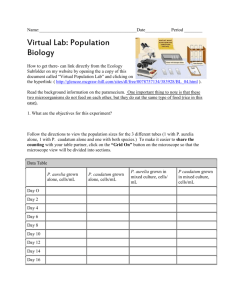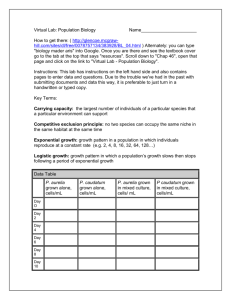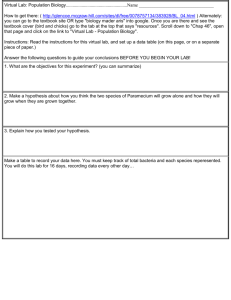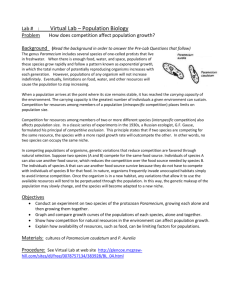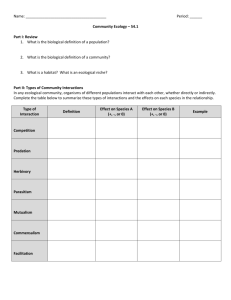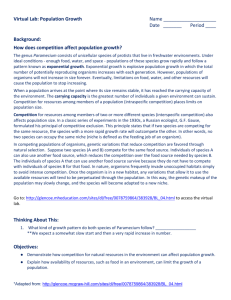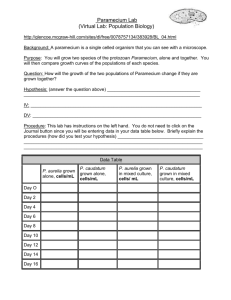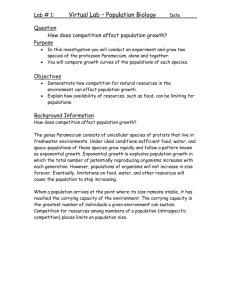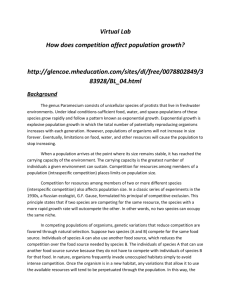Virtual Lab: Population Biology
advertisement
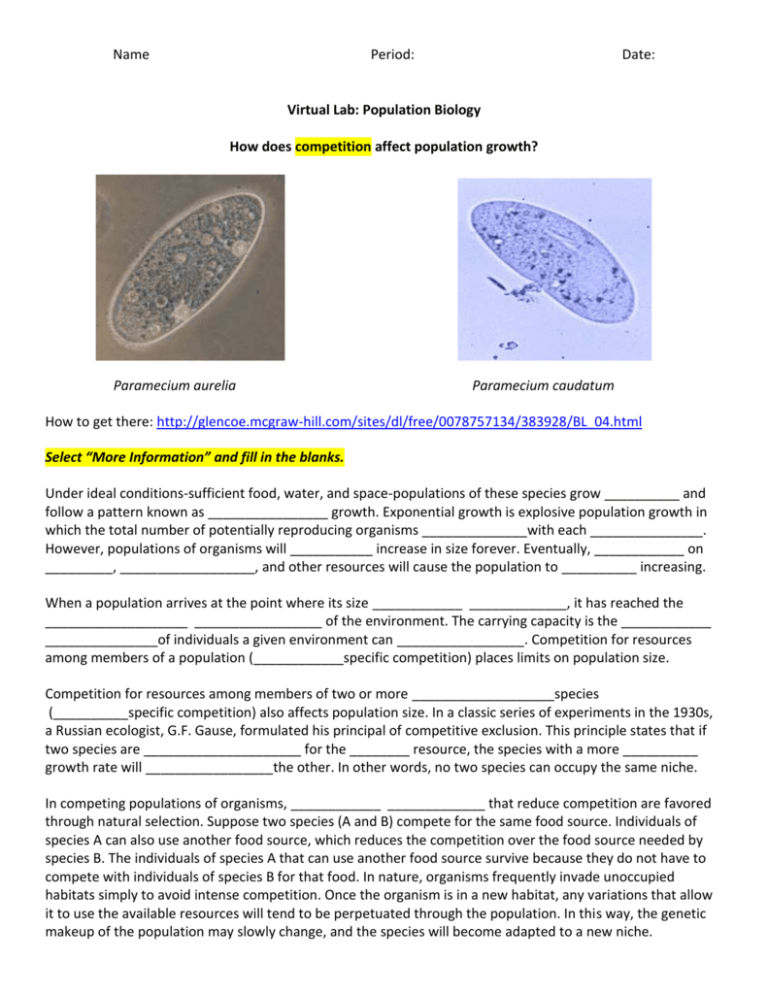
Name Period: Date: Virtual Lab: Population Biology How does competition affect population growth? Paramecium aurelia Paramecium caudatum How to get there: http://glencoe.mcgraw-hill.com/sites/dl/free/0078757134/383928/BL_04.html Select “More Information” and fill in the blanks. Under ideal conditions-sufficient food, water, and space-populations of these species grow __________ and follow a pattern known as ________________ growth. Exponential growth is explosive population growth in which the total number of potentially reproducing organisms ______________with each _______________. However, populations of organisms will ___________ increase in size forever. Eventually, ____________ on _________, __________________, and other resources will cause the population to __________ increasing. When a population arrives at the point where its size ____________ _____________, it has reached the ___________________ _________________ of the environment. The carrying capacity is the ____________ _______________of individuals a given environment can _________________. Competition for resources among members of a population (____________specific competition) places limits on population size. Competition for resources among members of two or more ___________________species (__________specific competition) also affects population size. In a classic series of experiments in the 1930s, a Russian ecologist, G.F. Gause, formulated his principal of competitive exclusion. This principle states that if two species are _____________________ for the ________ resource, the species with a more __________ growth rate will _________________the other. In other words, no two species can occupy the same niche. In competing populations of organisms, ____________ _____________ that reduce competition are favored through natural selection. Suppose two species (A and B) compete for the same food source. Individuals of species A can also use another food source, which reduces the competition over the food source needed by species B. The individuals of species A that can use another food source survive because they do not have to compete with individuals of species B for that food. In nature, organisms frequently invade unoccupied habitats simply to avoid intense competition. Once the organism is in a new habitat, any variations that allow it to use the available resources will tend to be perpetuated through the population. In this way, the genetic makeup of the population may slowly change, and the species will become adapted to a new niche. Instructions: Answer questions #1 and #2 BEFORE you run the experiment. 1. Click the top of the purple dropper on the left (P. caudatum) and drag to test tube 1 2. Click the top of the purple dropper on the right (P. aurelia) and drag to test 2 3. Click the top of each purple and drag to test tube3 4. Click on the microscope. Also click on the bottom to add the grid. This helps you count the bacteria. 5. Click on the clean microscope slides 6. Click on take samples 7. Click on slide 1 and drag it under the microscope. Count the # of specimens. Record in data table. 8. Click on slide 2 and drag it under the microscope. Count the # of specimens. Record in data table. 9. Click on slide 3 and drag it under the microscope. Count the # of specimens. Record in data table. 10. Click on clear slides and then click on Day (calendar). Two days later should show up. 11. Repeat steps 5-10 for each day up to day 16. Data Table and Questions. Data Table These 2 are from test tube #3 P. aurelia grown alone, cells/mL P. caudatum grown alone, cells/mL P. aurelia grown in P caudatum grown in mixed culture, cells/ mL mixed culture, cells/mL Day 0 Day 2 Day 4 Day 6 Day 8 Day 10 Day 12 Day 14 Day 16 Journal 1. What are the objectives for this experiment? (You can summarize) 2. Make a hypothesis about how you think the two species of Paramecium will grow alone and how they will grow when they are grown together. 3. Explain how you tested your hypothesis. 4. On what day did the Paramecium caudatum population reach the carrying capacity of the environment when it was grown alone? How do you know? 5. On what day did the Paramecium aurelia population reach the carrying capacity of the environment? How do you know? 6. Explain the differences in the population growth patterns of the two Paramecium species. What does this tell you about how Paramecium aurelia uses available resources? 7. Describe what happened when the Paramecium populations were mixed in the same test tube. Do the results support the principle of competitive exclusion? 8. Explain how this experiment demonstrates that no two species can occupy the same niche. 9. Make a line graph based on the data, on graph paper (next page). Title your graph and label axes. - days on the x-axis -# of cells on the y-axis. -Use 4 different colors for the paramecium cultures and provide a key.
